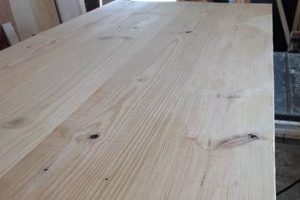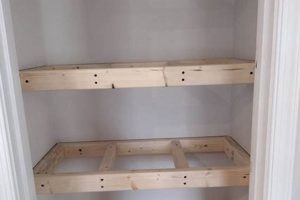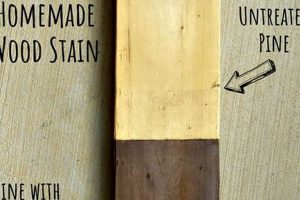Crafting seating from timber, employing individual design and construction methods, represents a popular form of woodworking. The projects, often undertaken by hobbyists or those seeking customized furnishings, involve utilizing lumber to create functional and aesthetically pleasing pieces for domestic use. Examples range from simple, three-legged designs to more elaborate structures incorporating intricate joinery and specialized finishes.
The appeal of this activity lies in its affordability, creative freedom, and potential for personalization. Compared to purchasing ready-made furniture, fabricating these items allows for significant cost savings and control over material selection, dimensions, and style. Historically, woodworking has provided essential household items, and contemporary approaches continue this tradition while incorporating modern tools and techniques to achieve diverse design outcomes. This approach contributes to sustainable practices through material reuse and longevity of crafted products.
The subsequent sections will explore different wood types suitable for these projects, fundamental construction techniques, and various finishing options to ensure durability and aesthetic appeal. These explorations will guide the creation of long-lasting and visually appealing seating solutions.
Construction Tips for Wooden Seating
The following guidelines offer practical advice for constructing durable and aesthetically pleasing wooden seating elements. Adherence to these principles enhances project success and ensures structural integrity.
Tip 1: Wood Selection is Paramount: Hardwood species such as maple, oak, or walnut provide superior strength and resistance to wear compared to softwoods like pine. Selecting appropriate lumber directly influences the finished product’s longevity.
Tip 2: Prioritize Accurate Measurements: Precise measurements are critical for stability and visual appeal. Utilize a measuring tape and square to ensure accurate cuts and joinery, mitigating potential structural weaknesses.
Tip 3: Joint Selection and Execution: Select appropriate joinery techniques based on the intended design and stress load. Mortise and tenon, dovetail, or dowel joints offer superior strength compared to simple butt joints secured with fasteners.
Tip 4: Surface Preparation is Essential: Sand all surfaces thoroughly before assembly and finishing. Progressive sanding with increasingly finer grits creates a smooth, even surface for optimal finish adhesion and aesthetic appearance.
Tip 5: Use Appropriate Fasteners: Select screws or nails suitable for woodworking applications. Ensure fasteners are of adequate length and gauge to securely join components without splitting the wood. Predrilling pilot holes prevents cracking.
Tip 6: Finishing for Protection and Aesthetics: Apply a protective finish, such as varnish, lacquer, or polyurethane, to seal the wood and protect it from moisture and wear. Multiple thin coats provide superior protection and a smoother finish compared to a single thick coat.
Tip 7: Clamp Strategically During Assembly: Employ clamps to ensure tight joints during gluing and fastening. Distribute clamping pressure evenly to prevent distortion or warping of the assembled components.
These recommendations are designed to improve the quality and durability of self-made wooden seating. Paying close attention to material selection, precision, and proper assembly techniques yields professional-grade results.
The subsequent article sections will delve into specific design considerations and advanced techniques to further enhance the capabilities of the woodworker.
1. Material Selection
Material selection exerts a direct influence on the structural integrity, longevity, and aesthetic characteristics of any self-constructed wooden seat. The type of wood chosen determines the stool’s ability to withstand weight, resist wear and tear, and maintain its appearance over time. For instance, constructing a stool intended for heavy use from a softwood like pine will likely result in premature failure or damage, compared to using a hardwood such as oak or maple. Similarly, a project aiming for a refined aesthetic benefits from hardwoods with attractive grain patterns. Thus, the choice of material is not merely a cosmetic consideration but a fundamental engineering decision.
Practical applications highlight the significance of material consideration. For a workshop stool requiring resistance to impacts and spills, a dense, closed-grain hardwood with a durable finish is advisable. Conversely, a lightweight, decorative stool might utilize a more easily workable softwood, provided the design compensates for its lower strength. The specific design requirements, intended use, and desired aesthetic qualities directly inform the optimal lumber selection. Furthermore, material selection must consider the joinery methods employed; some wood types are more conducive to certain joint types than others, impacting the overall structural integrity of the piece. Sourcing is also important, with sustainability and wood quality factored into the final decision.
In summary, appropriate lumber selection is paramount to achieving a successful self-made stool. It is a crucial decision point, directly affecting the project’s structural integrity, durability, and aesthetic appeal. Careful consideration of the intended use, design parameters, and joinery techniques is essential for optimal material choices. While cost may be a factor, prioritizing quality and suitability over price ensures a long-lasting and functional piece of furniture.
2. Joint Strength
The structural integrity of any wooden seating, particularly in do-it-yourself construction, is inextricably linked to the strength of its joints. The connection points between individual pieces of lumber determine the overall stability and weight-bearing capacity of the finished stool. Insufficient joint strength invariably leads to premature failure, compromising safety and functionality.
- Joint Type Selection
The selection of an appropriate joint type is fundamental to ensuring adequate strength. Mortise and tenon joints, dovetail joints, and dowel joints offer significantly greater resistance to tensile and shear forces compared to simple butt joints secured with screws or nails. The choice depends on the design aesthetic, expected load, and skill level of the constructor. For instance, a stool designed to support substantial weight requires robust mortise and tenon joints, while a lighter, decorative piece might utilize dowel joints. Improper joint selection compromises the entire structure.
- Material Compatibility
Different wood species exhibit varying degrees of suitability for specific joint types. Denser hardwoods, such as oak or maple, are generally more amenable to complex joinery, offering superior holding power for glue and fasteners. Softer woods, like pine, may require modifications to joint design or reinforcement to prevent splitting or crushing under load. The compatibility of the wood type and joint design is crucial for achieving optimal strength and long-term durability. Careful matching prevents joint failure due to material incompatibility.
- Precision of Execution
Regardless of the joint type selected, precision in execution is paramount. Accurate measurements, precise cuts, and tight fits are essential for maximizing joint strength. Gaps or misalignments weaken the connection point, rendering it susceptible to failure under stress. Employing appropriate tools and techniques, coupled with meticulous attention to detail, ensures that each joint functions as intended. Even the strongest joint design is rendered ineffective by poor craftsmanship. Clamping is important during glue application.
- Adhesive Selection and Application
The adhesive used in conjunction with mechanical joinery plays a critical role in enhancing joint strength. Wood glue formulated for specific wood types and applications provides a strong, durable bond that resists moisture and temperature fluctuations. Proper application techniques, including even distribution of glue and adequate clamping pressure, are essential for achieving optimal adhesion. Insufficient glue or inadequate clamping compromises the bond, reducing the overall strength of the joint. Correct glue usage maximizes connection stability.
The interplay of joint type selection, material compatibility, execution precision, and adhesive application collectively determines the overall strength of a wooden stool. A failure in any one of these areas diminishes the integrity of the entire structure, highlighting the importance of a comprehensive and meticulous approach to joint construction in any self-made wooden seating project. Stools that require frequent use will require the most strong joint strength.
3. Design Stability
Design stability is a paramount consideration in the creation of wooden seating. The structural integrity and safe usability depend directly on well-conceived design. Unstable seating poses a risk of injury and renders the piece unusable, negating the purpose of its construction. Therefore, thoughtful planning and execution are essential for crafting a secure and reliable structure.
- Leg Angle and Splay
The angle at which the legs are attached to the seat, known as the splay, significantly impacts the stool’s stability. A wider splay provides a broader base of support, resisting tipping forces. Conversely, legs positioned vertically or angled inward create an inherently unstable structure. Practical application involves calculating the optimal splay angle based on the seat height and intended use. Consideration must be given to the distribution of weight and the potential for off-center loading. The angle must allow adequate stability for the stool.
- Base Area and Footprint
The area encompassed by the stool’s legs, or its footprint, directly correlates with its stability. A larger footprint inherently provides greater resistance to tipping compared to a smaller one. Design considerations must account for the relationship between the stool’s height and footprint, ensuring that the center of gravity remains within the support base. For taller stools, a proportionally larger footprint is necessary to maintain equilibrium. A narrow base stool is suitable for static loads without much movement.
- Material Distribution and Weight
The distribution of weight within the stools structure influences its overall stability. A heavier seat combined with slender legs may create a top-heavy design, increasing the risk of tipping. Conversely, a lighter seat with robust legs provides a more stable base. Designers must carefully consider the weight of each component and its placement within the overall structure. Reinforcement elements, such as stretchers connecting the legs, can enhance stability by distributing weight more evenly. Weight distribution needs to be suitable.
- Joint Integrity and Rigidity
While leg angle and base area contribute to static stability, the rigidity of the joints is crucial for resisting dynamic forces. Weak or flexible joints compromise the stool’s ability to withstand movement and weight shifts, increasing the likelihood of wobbling or collapse. Robust joinery techniques, such as mortise and tenon or dovetail joints, are essential for creating a rigid and stable structure. Glue usage in joints is important to ensure a secure assembly.
These interrelated factors dictate the overall design stability of a wood stool. By addressing these considerations proactively, a robust, functional, and safe seating piece may be created. Careful attention to leg angle, base area, weight distribution, and joint integrity mitigates the risks associated with unstable design, ensuring a durable and reliable structure. If design stability is not ensured, the resulting stool may be a potential safety hazard.
4. Surface Finish
Surface finish, in the context of do-it-yourself wood stool construction, encompasses the processes and materials applied to the exterior of the object to provide protection, enhance aesthetic appeal, and modify tactile qualities. It is a crucial step, directly impacting the longevity, usability, and visual impression of the finished product.
- Protection Against Environmental Factors
Surface finishes act as a barrier against moisture, ultraviolet radiation, and physical abrasion. Without adequate protection, wood is susceptible to warping, cracking, discoloration, and decay. Exterior stools, in particular, necessitate robust finishes capable of withstanding prolonged exposure to weather. Examples include marine-grade varnishes and penetrating oil finishes designed to repel water and block UV rays. The selection of an appropriate finish is crucial for extending the lifespan of the wooden seating. Wood needs to be protected from humidity and insect.
- Enhancement of Aesthetic Qualities
Surface finishes can accentuate the natural grain and color of the wood, or alternatively, alter the appearance entirely through the application of stains and paints. Clear finishes, such as lacquer or shellac, provide a transparent layer that allows the underlying wood to be visible. Opaque finishes, such as enamel paints, offer a wider range of color options and can conceal imperfections in the wood. The choice of finish depends on the desired aesthetic outcome and the specific characteristics of the wood used. Finishes will enhance the appeal of the wood.
- Modification of Tactile Properties
The surface finish dictates the texture and feel of the wooden stool. Smooth, glossy finishes offer a sleek, modern aesthetic, while matte or textured finishes provide a more rustic or tactile experience. The application technique and the type of finish used influence the final surface feel. For example, multiple coats of varnish, sanded between applications, result in a smoother surface than a single coat. The right finish improves usage.
- Safety and Hygiene Considerations
Certain surface finishes are specifically formulated to be food-safe or non-toxic, making them suitable for stools intended for use in kitchens or dining areas. These finishes resist the absorption of liquids and are easily cleaned, preventing the growth of bacteria and mold. Examples include polyurethane finishes approved for contact with food. The selection of a safe finish is particularly important for stools used by children or individuals with allergies. Clean surfaces are an essential part of furniture that is used on a daily basis.
The selection and application of surface finishes are integral to the successful completion of any self-made wooden seat. A well-chosen and properly applied finish not only protects the wood and enhances its aesthetic appeal but also contributes to the overall usability, safety, and longevity of the finished product. Each finish has different composition that user can use.
5. Ergonomic Comfort
Ergonomic comfort constitutes a critical factor in the design and construction of wooden seating, influencing user well-being and long-term satisfaction. The physical dimensions, contours, and materials employed in a self-constructed stool directly affect posture, pressure distribution, and overall comfort during use. Neglecting ergonomic principles can lead to discomfort, fatigue, and potentially musculoskeletal issues.
- Seat Height and Posture
Appropriate seat height is paramount for maintaining proper posture and reducing strain on the lower back and legs. A seat height that is too low forces the user to hunch forward, while a seat height that is too high causes the user to perch or strain to reach the floor. Ideal seat height allows the user to sit with their feet flat on the floor and their knees bent at a 90-degree angle. Adjustable-height stools offer versatility, accommodating individuals of varying statures. The stool must be adjustable.
- Seat Contour and Pressure Distribution
The shape and contour of the seat influence pressure distribution across the buttocks and thighs. A flat, hard seat concentrates pressure on bony prominences, leading to discomfort and potential circulation problems. A contoured seat, shaped to conform to the natural curves of the body, distributes pressure more evenly, reducing discomfort and improving circulation. The material also plays a role, with softer materials providing greater cushioning and pressure relief. The seat can be made by soft and solid parts.
- Back Support and Lumbar Curvature
For stools with backrests, adequate lumbar support is essential for maintaining proper spinal alignment and reducing strain on the lower back. The backrest should be shaped to support the natural curve of the lumbar spine, preventing slouching and promoting good posture. Adjustable backrests allow users to customize the level of support to their individual needs. A backrest needs to be provided.
- Footrests and Leg Support
Footrests provide support for the feet and legs, reducing pressure on the thighs and improving circulation. Footrests are particularly important for taller stools, where the feet may not reach the floor. The height and position of the footrest should be adjustable to accommodate users of varying heights. The legs will be in good position when using the footrest.
By incorporating these ergonomic principles into the design and construction process, individuals can create wooden seating that is not only aesthetically pleasing but also comfortable and supportive. Prioritizing ergonomic considerations enhances the user experience and promotes long-term well-being, transforming a simple woodworking project into a valuable and health-conscious addition to any living or working space.
6. Tool Proficiency
The successful construction of wooden seating hinges significantly upon the individual’s level of tool proficiency. Competence in operating woodworking tools directly impacts the precision, safety, and overall quality of the finished product. Insufficient skill leads to inaccuracies, potential hazards, and compromised structural integrity.
- Measuring and Marking Tools
Accurate measurement and marking are foundational to woodworking. Tools such as measuring tapes, squares, marking gauges, and pencils ensure precise dimensions and alignment of components. For instance, a miter saw relies on accurate angle markings to ensure the stool’s legs are cut to the correct splay for stability. Inaccurate measurements result in mismatched parts and a structurally unsound stool. Precision tools are a must.
- Cutting Tools
The effective use of saws, chisels, and planes is essential for shaping and sizing wooden components. Saws are employed for rough cuts, while chisels and planes refine surfaces and create joinery. Competent use of these tools ensures clean, accurate cuts, which are critical for tight-fitting joints. For example, creating a mortise and tenon joint requires precise chisel work to ensure a strong and secure connection between the stool’s legs and seat. If there is incorrect usage there will be errors in measurement.
- Joinery Tools
Creating strong and durable joints requires specialized tools such as drills, dowel jigs, and mortising machines. These tools facilitate the precise creation of mortises, tenons, and dowel holes, which are necessary for assembling the stool’s components. Proper tool use ensures that the joints are aligned correctly and securely fastened, preventing wobbling or collapse. Joinery tools make a better result.
- Finishing Tools
Achieving a smooth and durable finish requires proficiency in using sanding tools, brushes, and spray guns. Sanding prepares the wood surface for finishing, while brushes and spray guns apply the finish evenly and consistently. Proper tool use ensures a professional-looking finish that protects the wood and enhances its aesthetic appeal. Sanding smoothness also needs to be applied.
In summation, the degree of tool proficiency directly influences the outcome of any wooden seating project. Competence in using measuring tools, cutting tools, joinery tools, and finishing tools translates to a higher quality, safer, and more durable product. Skillful tool use is not merely a technical requirement, but a fundamental element of successful woodworking.
7. Wood Treatment
Wood treatment, in the context of self-made wooden seating, represents a critical process affecting the material’s longevity and resistance to environmental degradation. The application of preservatives and protective coatings directly mitigates the susceptibility of lumber to decay, insect infestation, and moisture-related damage. Without appropriate treatment, even carefully constructed stools can deteriorate rapidly, particularly when exposed to outdoor conditions. The implementation of wood treatment directly impacts the long-term viability of the seating.
Consider, for example, a simple pine stool constructed for garden use. Untreated pine is highly vulnerable to rot and insect attack. Within a relatively short period, moisture penetration fosters fungal growth, leading to structural weakening. Termites or other wood-boring insects exacerbate the damage, compromising the stool’s stability. Conversely, pressure-treated lumber, or lumber coated with effective preservatives, exhibits significantly enhanced resistance to these destructive forces. Furthermore, finishes such as varnish or paint provide an additional barrier against moisture and ultraviolet radiation, extending the stool’s lifespan and maintaining its aesthetic appeal. Proper treatment will give strength and safety in wood structure.
In summary, wood treatment constitutes an indispensable component in the creation of robust and enduring wooden stools. It mitigates vulnerabilities inherent in the material, safeguarding against decay, insects, and environmental damage. While selection of lumber and construction techniques are of importance, the absence of appropriate wood treatment will diminish the value of stool. Therefore, the process is critical for ensuring the longevity, safety, and aesthetic integrity of self-made wooden seating.
DIY Stool Wood
The following section addresses common inquiries and clarifies uncertainties surrounding the self-directed construction of wooden seating. The responses provide factual information to guide informed decision-making.
Question 1: What types of wood are most suitable for crafting stools?
Hardwood species such as oak, maple, walnut, and cherry are generally preferable due to their superior strength, durability, and resistance to wear. Softwoods like pine and fir can be used, but often require additional reinforcement or are better suited for decorative applications.
Question 2: What is the minimum set of tools required for constructing a wooden stool?
Essential tools include a measuring tape, square, saw (hand saw or power saw), drill, screwdriver, sandpaper, and clamps. Additional tools such as a chisel, plane, and router can enhance precision and expand design possibilities.
Question 3: How can the stability of a self-made wooden stool be ensured?
Stability is achieved through careful design considerations, including leg angle (splay), base area, and joint strength. Wider leg splay and robust joinery, such as mortise and tenon or dovetail joints, enhance stability. Careful measurement and execution are also critical.
Question 4: What type of finish is recommended for protecting a wooden stool?
The appropriate finish depends on the intended use and desired aesthetic. Polyurethane finishes provide excellent durability and water resistance. Varnish offers good protection and enhances the wood’s natural grain. Oil finishes penetrate the wood, providing a natural look and feel. The finish should be selected based on the specific requirements of the project.
Question 5: How can wood be protected from moisture and insect damage?
Wood can be protected by applying preservatives, such as borate-based treatments, which inhibit fungal growth and deter insects. Sealants, such as varnish or paint, also provide a barrier against moisture penetration. Regular inspection and maintenance are essential for identifying and addressing potential problems early.
Question 6: What safety precautions should be observed when working with woodworking tools?
Safety glasses should be worn to protect the eyes from flying debris. Hearing protection is recommended when operating power tools. Dust masks or respirators should be used to avoid inhaling sawdust. Power tools should be used according to the manufacturer’s instructions. A clean and organized workspace minimizes hazards.
These answers provide foundational knowledge for undertaking wooden seating projects. Prudent application of these guidelines contributes to successful outcomes.
The next section will explore advanced techniques in diy wood stool.
Conclusion
This discourse has explored the multifaceted aspects of self-directed wooden seating construction. Key considerations include appropriate material selection, robust joint construction, stable design principles, effective surface finishing, ergonomic comfort factors, tool proficiency, and essential wood treatment techniques. Each element contributes significantly to the creation of functional, durable, and aesthetically pleasing pieces.
The successful application of these principles empowers individuals to produce customized furnishings while fostering an appreciation for craftsmanship and material stewardship. Continued attention to detail and adherence to sound construction practices will further refine woodworking skills and yield lasting, valuable creations.







